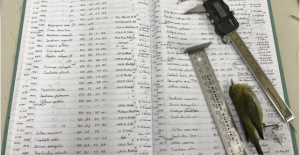Every day in the spring and fall since 1978, scientists and volunteers at Chicago’s Field Museum have gotten up as early as 3:30 in the morning to collect fallen birds that have crashed into nearby buildings’ windows.
One scientist, Dave Willard, has measured every single one of the dead birds and recorded the data by hand into a ledger.
That meticulous note-keeping paid off: scientists analyzed the data and learned that over the last forty years, migratory birds have been getting smaller-a change likely linked with climate change.
“When we began collecting the data analyzed in this study, we were addressing a few simple questions about year-to-year and season-to-season variation in birds. The phrase ‘climate change’ as a modern phenomenon was barely on the horizon. The results of this study highlight how essential long-term data sets are for identifying and analyzing trends caused by changes in our environment,” says Willard, a collections manager emeritus at the Field Museum and one of the authors of a new study in Ecology Letters presenting these findings, along with lead author Brian Weeks and senior author Ben Winger from the University of Michigan.
Read more: archaeology news network
Ask me anything
Explore related questions





